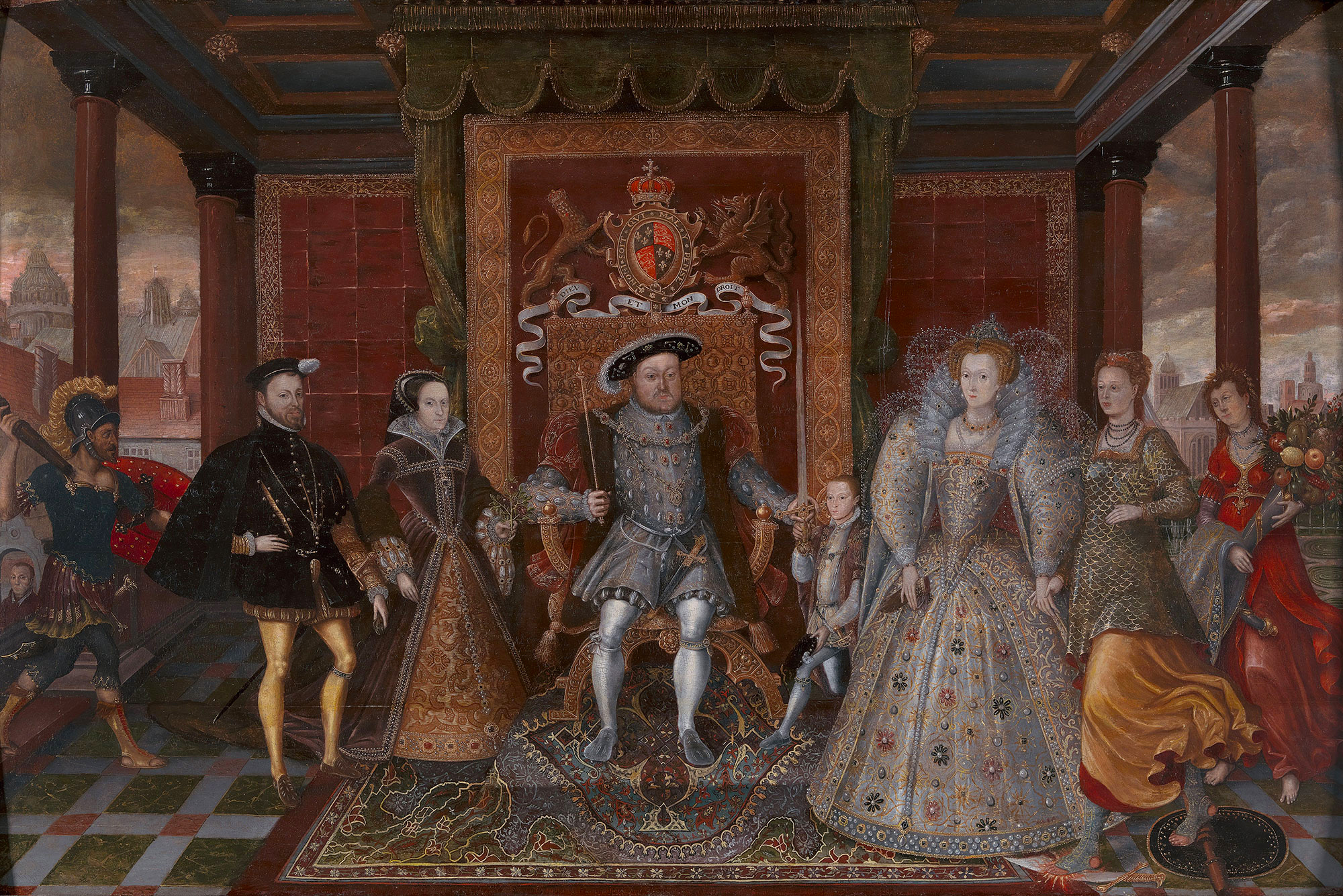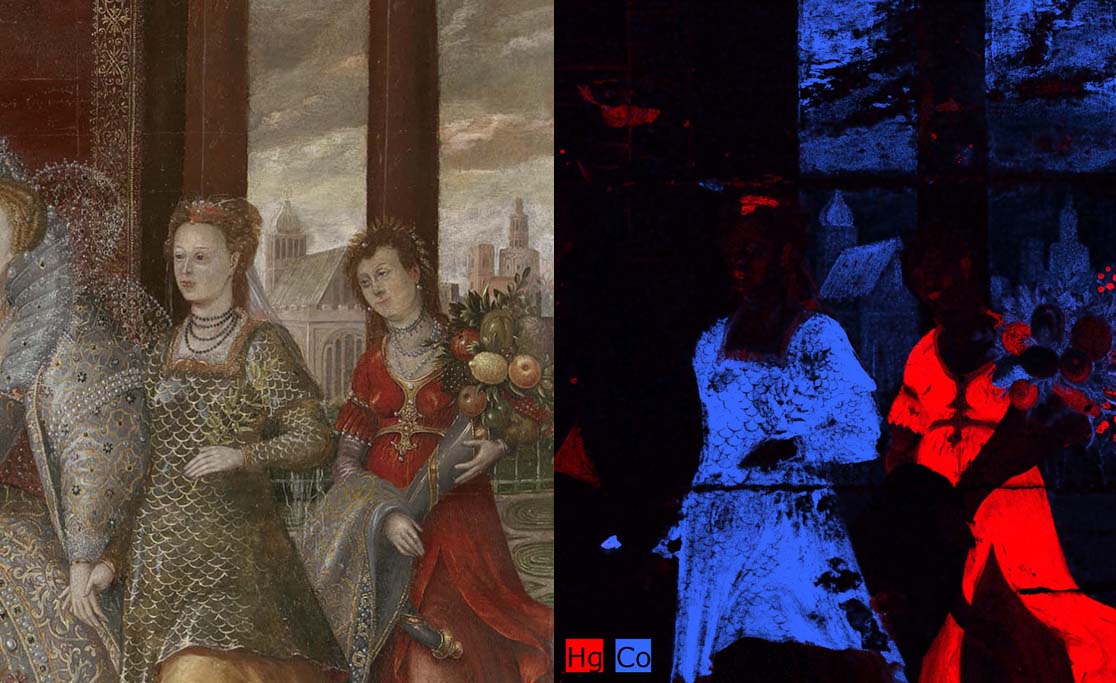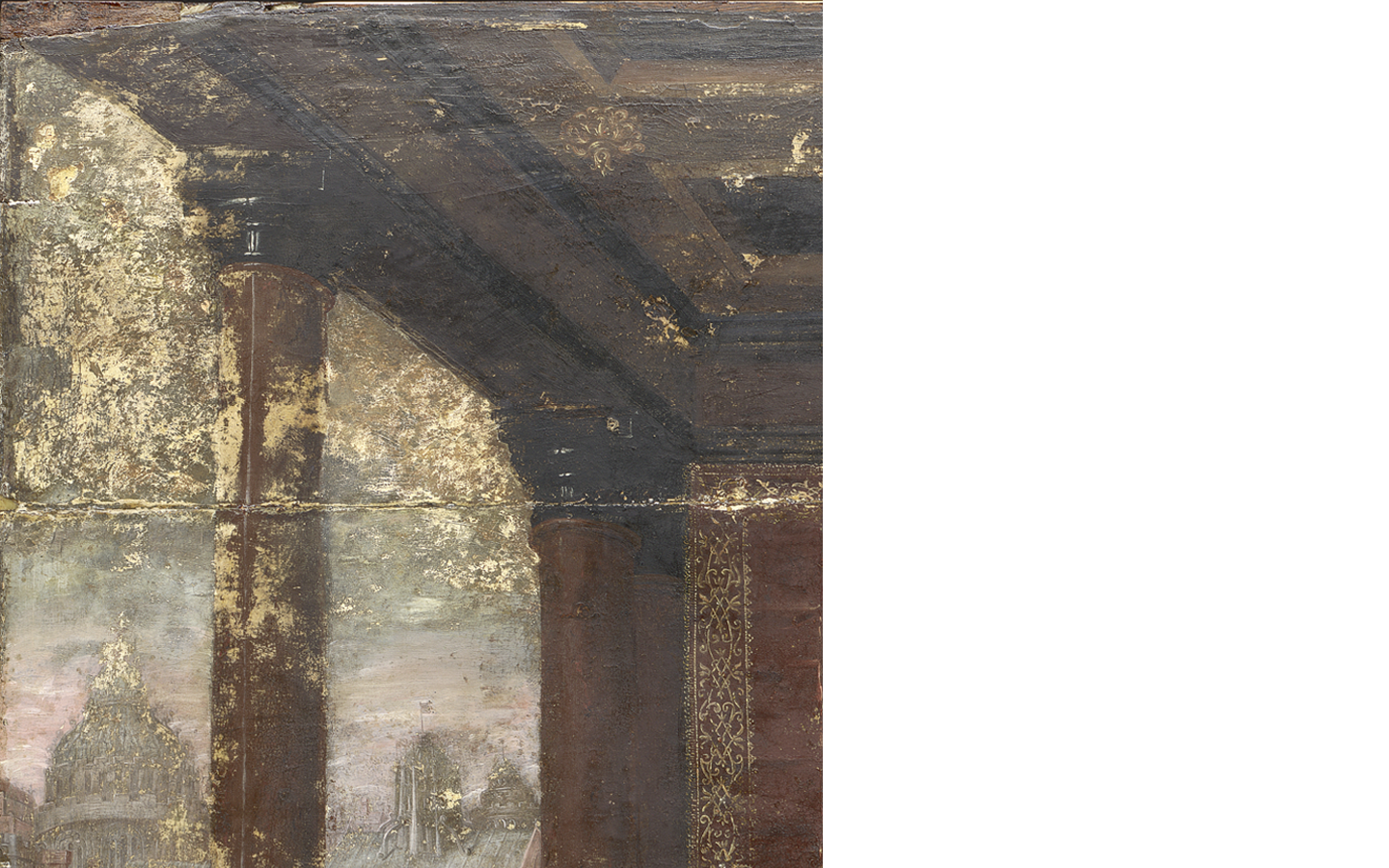An Allegory of the Tudor Succession—one of the oldest objects in the Yale Center for British Art's collection and its only painted depiction of the Tudor monarchs—was removed from view for conservation work in February 2019. The painting will travel to the Metropolitan Museum of Art for panel conservation in spring 2023.

Unknown artist, sixteenth century, An Allegory of the Tudor Succession: The Family of Henry VIII, ca. 1590, Oil on panel, Yale Center for British Art, Paul Mellon Collection
Made by an unidentified artist around 1590, during the last two decades of the Tudor dynasty, the painting portrays Henry VIII with his three children: Mary, a Catholic, and Elizabeth and Edward, both Protestants. With his left hand, Henry passes his sword—an emblem of his authority—to his son, Edward VI, who kneels at Henry’s side to accept his role as king and head of the Protestant Church of England.
Edward’s successor, Mary I, and her husband, Phillip II of Spain, are villainized in this view of recent history, favoring an Elizabethan and firmly Protestant perspective. Positioned on the left side of the painting, the couple is accompanied by an allegorical figure of War. Elizabeth I, who succeeded Mary, appears on the right side of the painting, hand-in-hand with Peace. Plenty carries Elizabeth’s train as well as a cornucopia of fruits and flowers, symbolizing the blessings and bounties of the Elizabethan regime. In reality, England spent much of Elizabeth’s reign at war, and the last decades of her rule were marked by economic hardship and social unrest.
Before restoration began, the painting was examined using traditional examination techniques: microscopy, x-radiography, ultraviolet and infrared imaging, and x-ray fluorescence (XRF) scanning. The process uncovered detailed information about the pigments used to create the painting and revealed copious old restorations. The unidentified artist used a range of pigments, from costly vermilion red to inexpensive smalt (cobalt-based) blue.

Before treatment detail (left) and X-ray fluorescence (XRF) scan (right) showing the distribution of mercury- and cobalt-containing material at the right side of the painting, which corresponds to vermilion red (shown in red) and smalt blue (shown in blue) respectively. XRF data were collected using a Bruker M6 Jetstream scanner in collaboration with Yale’s conservation scientists at the Institute for the Preservation of Cultural Heritage.
The use of the unstable smalt caused the once-brilliant blue skies to darken over time. Sometime before the painting entered the museum's collection, a previous conservator attempted to clean the sky, unaware that the discoloration was not dirt but the original oil paint. This misunderstanding of the discolored smalt resulted in the disruptions in the sky that viewers see today.

Detail of An Allegory of the Tudor Succession: The Family of Henry VIII showing paint loss in the upper left corner of the panel where smalt was present
During the first phase of the project, Jessica David, Senior Conservator of Paintings at the YCBA, removed the discolored varnish and a mid-twentieth-century restoration over the course of several months. As photos taken during this phase of treatment show, the paint layer appears less saturated where the varnish is removed, and the damage to the painting’s surface is increasingly exposed.
In spring 2023 the painting will travel to the Metropolitan Museum of Art, New York, where panel paintings conservators will treat the painting’s support, an oak panel comprised of five boards that have begun to come apart along the joins. Panel conservators will remove wooden battens that were glued to the back of the panel during a previous restoration.

Overall view of the back of the panel showing non-original horizontal battens and thinner wood strips that were added in a previous restoration and are now placing stress on the original oak construction.
YCBA conservators believe the battens were added in the first half of the previous century in order to stabilize the panel, but the battens now impose stress on the construction and are causing flaking on the front. Once the battens are removed, the condition of the original wood support will be reassessed, and the panel will be stabilized with a less aggressive system of support that will not cause further deterioration.
In early 2024 the painting will return to the Yale Center for British Art, where David will retouch the losses across the painting’s surface. Most of the paint loss is located along the panel’s joins, where both the original paint and the chalk-based preparatory layers are missing and the wood panel is exposed.

Detail of An Allegory of the Tudor Succession: The Family of Henry VIII showing paint loss along the panel's joins and historical vandalism in the form of puncture marks on Edward’s eyes
Those damages will first be filled to compensate for the difference in depth between the level of the wood and the surface of the paint. The remaining losses will then be retouched using a conservation retouching medium, which is distinctive in composition from the original oil paint.
The retouching will take place in several stages, beginning with toning the newly filled damages to an appropriate base color, then adding glazes of color to minimize the appearance of the damage and visually knit those passages together. All restoration will be added above an “isolating” varnish layer, which separates the original painting from the new retouching, making this restoration easily reversible by future conservators.
The fully restored painting—the result of nearly three years of restoration at two conservation studios—will be included in a forthcoming exhibition on Elizabethan portrait paintings, which David will co-curate with Edward Town, Assistant Curator of Paintings and Sculpture. The YCBA will also publish an exhibition catalogue, to be authored by David, Town, and Jemma Field, Associate Director of Research.
Top image
Unknown artist, sixteenth century, An Allegory of the Tudor Succession: The Family of Henry VIII, ca. 1590, Oil on panel, Yale Center for British Art, Paul Mellon Collection
Structural Treatment of “An Allegory of the Tudor Succession” — Phase 2
The complex construction of “An Allegory of the Tudor Succession” required YCBA conservators to collaborate closely with specialists at the Metropolitan Museum of Art.